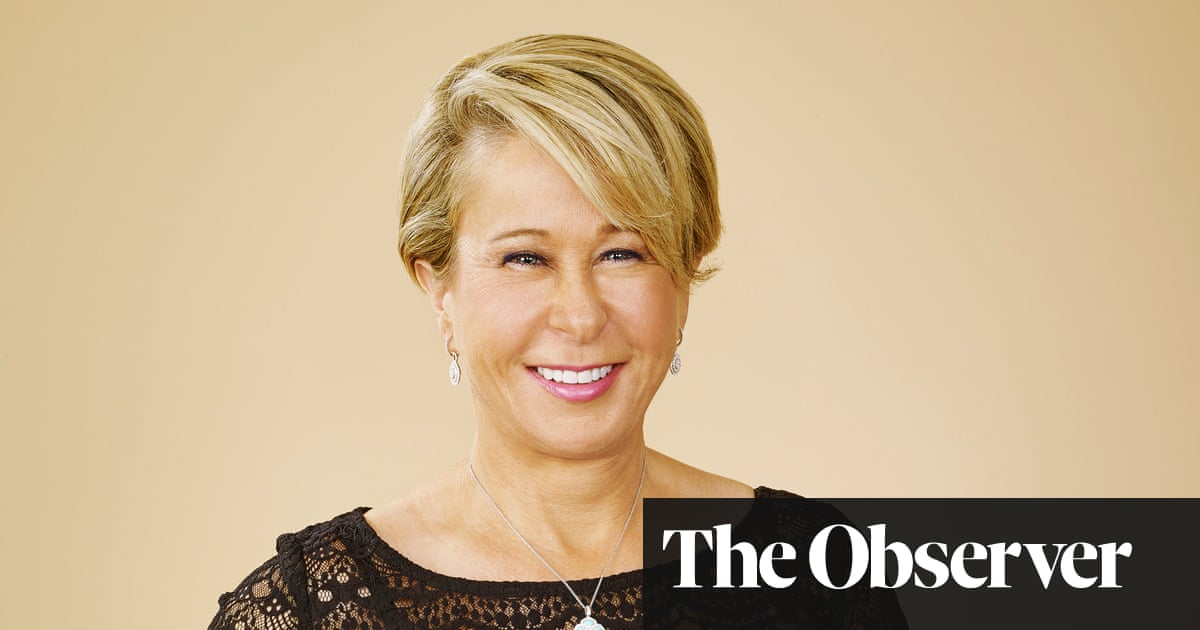
n February 2012, Rhian was a happy, busy wife, mother of three and a PE teacher in Cardiff. She and her husband, Paul, had met on a blind date in their early 20s. “I knew as soon as we met that I wanted to be with him for ever.” Paul was handsome, kind and “sports-mad”; he was Rhian’s rock, she says. By the end of their honeymoon, she was pregnant, while their third child, George, celebrated his first birthday on Valentine’s Day 2012. He was a smiley baby, giggling, crawling everywhere, saying “hiya” all the time. “It was everything I’d ever wanted,” Rhian says.
A week after that birthday, Rhian and George were playing together after his bath when he had a seizure. An ambulance was called, but two hours after arriving at hospital, George died. Rhian says: “The nurse carried his body out of A&E and through the hospital corridors and found a closed children’s day unit, with cartoon characters all over the walls, cots with teddy bears in. That’s where we said goodbye to our little boy.” In her memory, she watches the scene from above, hovering over it as if in a dream. “That emotion of shock saves you in a way; it protects you. Because I didn’t feel anything.” They had left home with their youngest son; they returned without him. “George’s birthday cards were still up, and his presents were in a pile in the corner – but in the other corner was his vomit from when he fell ill, and bits of his clothing that had to be cut off him.”
In the days that followed, there were friends, family, cups of tea, memories, hope, devastation, silence and hugs. Five days after George’s death, Paul’s state of mind shifted. “He was saying it was his fault, that he had let me down as his wife, and the children,” says Rhian. He went for a drive, but hadn’t returned an hour later. There was a knock on the door. “I could see a police officer in uniform and … you know,” she says. The police officer told Rhian that Paul was dead. She says: “I can just remember putting my hand on the policeman and saying it was OK, because he was showing emotion, and then my whole body went. I wet myself, I started dribbling and being sick down myself. It went on for days and days, and I couldn’t lift my head off my chest.” It would be four months before she would learn that George had died from pneumonia and influenza A, which can be symptomless. Paul had taken his own life.
Shortly after the ninth anniversary of their deaths, she tells me: “It’s taken a long time to understand the person I am again, and to find a purpose.” Now, she is Rhian Mannings MBE, the founder and CEO of 2 Wish Upon a Star, a charity that has supported more than 3,300 people in Wales affected by the sudden death of a child or young person. She recently won a Pride of Britain award, and last year married Craig, a man she met through the charity. She says: “I went through all this trauma. I was knocked off my feet to a place that I never want to experience again. I went right downhill, but then I came back up. I know it’s made me a different person, a better person.”
The shape of Rhian’s story, of growth out of trauma, is as old as humanity. It is a narrative that links the Bible, Nietzsche and women’s magazines, a trajectory we can trace in the lives of Hercules, Maya Angelou, Harry Potter, Doreen Lawrence, Nelson Mandela and Joe Biden. It is the story of hope: that we might grow through suffering, that we might emerge on the other side changed, “a better person”. We may well wonder, after a pandemic that has meant trauma, loss and illness to so many, can a better understanding of what happened to Rhian help us to grow from this experience, as she has?
In the 80s, Richard Tedeschi was an academic in the psychology department of the University of North Carolina when he and a colleague, Lawrence Calhoun, discovered a shared interest in the question of wisdom. They began interviewing people who might have accrued it through the survival of difficult experiences, including bereavement. Tedeschi and Calhoun coined the name post-traumatic growth to describe what they saw. Their first book was published in 1995, and, Tedeschi says: “We had one heck of a time trying to get anyone to publish it.” Twenty-five years on, Tedeschi is distinguished chair of the Boulder Crest Institute for Post-Traumatic Growth, and the measure he and Calhoun designed, the index of post-traumatic growth, is used all over the world.
Post-traumatic growth, Tedeschi explains, means “the positive changes that occur in the aftermath of a trauma as a result of the process of a struggle with these traumatic events”. Regardless of what shape the trauma takes, he says, whether it’s war, unemployment, bereavement, a car accident or a natural disaster, “the processes and outcomes are very similar”. He lists five areas of growth that people speak of in the aftermath of their suffering: increased personal strength; increased connection with and compassion towards others; greater appreciation and gratitude for their life, especially the small things; they might find a new mission in life; and they undergo an existential change, engaging with questions about the purpose, meaning and value of their life. Different studies have suggested that 58-83% of trauma survivors report a positive change in at least one area.
The process begins when the traumatised person is able to calm their anxiety and feel less overwhelmed by their emotions – and that often requires help. There follows a period of deliberate reflecting, putting things together, with the help of a person Tedeschi calls an “expert companion”; expert at listening, but not necessarily a professional. It could be a therapist, a friend or family member, “someone you can be open with, who’s accepting, who isn’t going to give you simple answers or platitudes or just give you advice – someone who’s going to go on a journey with you”.
At some point in the first year after losing her son and husband, Rhian was told by her mother that she seemed to be “existing, but not living”. Rhian was desperate to give her children stability: she got out of bed every morning to dress them for nursery, and she bathed and fed them afterwards, and in between she would “dribble and retch all day until they came home. I didn’t want to do anything or touch anything that reminded me of what I’d had,” she says. “I’ll never forget what my mum told me, because she was right – I needed to live.”
The start of that path towards life was also the start of 2 Wish Upon a Star. While accepting nothing could have been done to help George, Rhian believes Paul’s death could have been prevented. “Nobody told us that when a child dies, you’re going to blame yourself, you’re going to feel angry. We needed someone who understood to talk us through it, and that person never came. Someone should have been there to look after him and me,” she says. Rhian became determined “to put a bit of that right”.
She knew from her own experience that hospitals were not equipped to support the suddenly bereaved. Staff had to rush around to try to find something to make George’s handprints, and provide a place for them to sit in peace with their son. They had had no emotional support in the aftermath. Friends and relatives fundraised to build a family room in the hospital so that, Rhian says: “no other family has to make that walk – so that they’ve got somewhere there.” She built family rooms in other hospitals; introduced memory boxes for parents to keep locks of hair and other mementoes; trained staff; introduced counsellors; organised the provision of immediate support for bereaved families like hers. The charity grew, and made agreements with every police force and health board in Wales that when a child dies, the family is referred to them, with parental consent.
Then, in 2016, she burned out. “One day I just couldn’t get out of bed. I think my body said, you’ve had enough. And that’s when I started to see my psychotherapist,” she says. Once a week for one year, she talked to him about her self-hatred, the sense of guilt she couldn’t shake; the longing for Paul and George to be back with her, alive; the mask she had been wearing. She was diagnosed with PTSD. “He changed everything,” she says. “He made me accept what happened. Nothing I did would ever bring them back. And if I was going to stay on this earth, and I’ve never thought of anything else, then I had to make sure I led a good life. I couldn’t allow the boys’ deaths to mean nothing, I couldn’t let them be forgotten.”
It sounds as if this is when she began to grow. It echoes the distinction Tedeschi makes between someone who is experiencing post-traumatic growth, and someone who desperately wants to be happy again. “Post-traumatic growth is not happiness,” he says. “It often coexists with distress.” It is the opposite of being a Pollyanna; rather, it is an experience of loss and mourning so profoundly painful that it changes you for ever. “It’s hard-won wisdom,” Tedeschi says. “It’s knowing things viscerally or in your bones. It’s easy to say: ‘Appreciate life!’ or ‘Treat other people well!’, but doing that in the aftermath of a transformative trauma is a different way of understanding. It’s living it, having it in your gut.”
Eranda Jayawickreme, associate professor of psychology and director of the Growth Initiative Lab at Wake Forest University, North Carolina, says he and Tedeschi have sparred over the science of post-traumatic growth. It’s not that Jayawickreme doesn’t believe it is real; he saw it as a child in Sri Lanka, where he met many people affected by the civil war and insurrection. “Although my family were mostly insulated from a lot of what happened, I saw first-hand the possibility that people could grow, following the experience of adversity.” But, he says, during his research, “I realised that post-traumatic growth is such a compelling idea, we have a very strong motivation to believe in it. As a scientist, that gave me some pause.”
Among other issues, he questions how common post-traumatic growth is; he thinks the quality of some of the research “should make us sceptical of many of the findings”. This, he argues, is because of the way it is measured, through a subjective assessment by the individual. A person might wish they have grown, might feel they have grown – but this doesn’t necessarily mean, Jayawickreme argues, that they have. He explains: “We haven’t done a very good job of distinguishing post-traumatic growth as transformation and post-traumatic growth as a story that we tell to help us make sense of our experiences and reconcile ourselves to the implications of whatever we’ve been through.” While he and Tedeschi have been critical of each other’s work, Jayawickreme says: “I think he and his colleagues have done a great service by making this a popular area of study. My view is we now need to move on to the next step.”
Tedeschi’s definition of trauma is interesting. “We don’t define it in terms of a list of traumatic events,” he says. “Instead, we define it in terms of the impact of events on the core belief system that people have.” Most of us probably aren’t aware this core belief system exists, until it shatters, as Rhian’s did. There is a difference between resilience – where people bounce back from adversity, and go back to how things were before, which was impossible for Rhian – and post-traumatic growth, Tedeschi explains. “People who are resilient don’t grow in the aftermath of a certain event, because they don’t need to grow – they’re resilient to it.” I wonder if the pandemic will have been a trauma for us all, and he tells me: “It may not necessarily be a trauma for everyone. It depends on your core belief system.”
For some, post-traumatic growth may be possible, if they have the right support. But for others, Jayawickreme thinks, a narrative of growth out of the pandemic could be experienced as oppressive: if someone was already struggling to make ends meet before the pandemic, then lost a loved one, lost their job and was pushed into poverty, and now feels they are being told to grow, the notion of post-traumatic growth might well feel insulting. A person’s capacity for post-traumatic growth may depend on their personal experiences, resources, and structural advantages – or lack of them.
Tedeschi says that post-traumatic growth does not happen only with individuals, but also in systems, communities, nations. Can we see it in the birth of the NHS in 1948, out of the horror and losses of the second world war? This is how I see the birth of 2 Wish Upon a Star in 2012: as a fierce, mighty kind of care, rising up from pain a person should never have to face, but did. What growth might be possible for us, for our society, after Covid?
It was while she was having therapy that Rhian met her husband, Craig. She started exercising, spending more time with her children, taking pleasure in them. This year, sitting together at the table on Mother’s Day, she felt: “That’s all that matters.” When Rhian says it, it doesn’t sound like a cliche. “It took me a long time to sit at the table,” she says. “For years and years, I couldn’t because it reminded me of what I lost.” She finds joy, as Tedeschi described, in the small things. “Walking the dog and just feeling a bit of sun on my face. I love running in the rain because I feel I’m alive again. Paul and George will never experience any of this again, so everything I do, I want to savour and experience and appreciate.”
I ask Rhian what she makes of the idea of post-traumatic growth. She’s never heard of it before, but after she looks it up, she says: “My God, that’s me.” Rhian shows that to experience post-traumatic growth is to contain, to live, conflicting truths. “I still have bad days, but they’re different bad days. My heart is still broken, and in many places,” she says. “We have a really good life.”












